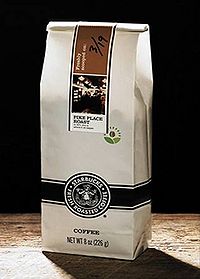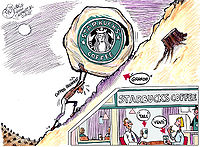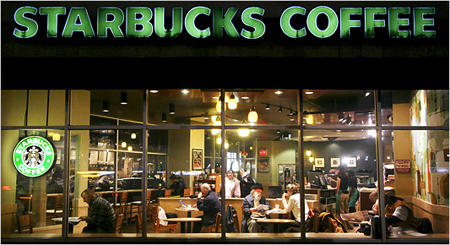Course:HIST104/Pike Place Roast
| Starbucks Pike Place Roast | |
|---|---|
[[ | |
| HIST 104 - Topics in World History | |
| Section: | 98A |
| Instructor: | Frederick Vermote |
| Joy Dixon | |
| Email: | |
| Office: | |
| Office Hours: | |
| Class Schedule: | |
| Classroom: | |
| Important Course Pages | |
| Syllabus | |
| Lecture Notes | |
| Assignments | |
| Course Discussion | |
Starbucks Pike Place Roast
The Pike Place Roast is known as one of Starbucks’ specialty roasts.[1]. Created in 2008, the Pike Place Roast is a blend of dark beans, said to carry a bold flavor and a rich taste.[2]. The blend was created in order to celebrate the coffee company’s first location in Seattle’s Pike Place Market, which originally opened in 1971 [3]. Starbucks achieved this specialty blend by: redefining the flavor of one of their older coffees, serving it in their original logo coffee cups exclusive to this blend, as well as having this logo on the Pike Place Roast packaging[4]. The company has further reintroduced some of their classics by choosing to create this specialty blend out of coffee beans supplied from some of their original coffee providers. This specialty blend was grown where coffee originated, in the Arab world[5].
Coffee's Beginnings
The Pike Place Blend is said to be a “proprietary blend of high-altitude Arabica beans"[6]. These beans are a perfect example of a historically significant product because it created new lines of communication and contact between different societies. The coffee plant was originally founded in Ethiopia, but later spread to other bordering countries in the Arabian Peninsula such as Egypt and Yemen[7]. The coffee plant could be grown in mild to hot temperatures, did not require large land clearings to produce, and did not require many tools to cultivate[8]. The beans were originally picked off the plant and chewed[9]. However, a technique for picking the beans when they were ripe and then boiling them to form a liquid substance, soon became the ideal[10]. The spread to neighboring countries began a new chain of Islamic growers, working similarly to maintain this specialty product.
Early Uses and Trade
Ethiopian mystics and monks first used coffee beans in order to keep alert during evening prayer. Due to coffee’s strong stimulating abilities that did not impair people like alcohol was known to, coffee was quickly adopted by neighboring Arabian countries with similar religious purposes in mind [11]. However, coffee soon became a popular drink for the common people, as it was later served at home, as well as in new social arrangements called coffeehouses[12]. During the new age of exploration, many travelers and merchants were intrigued by the popularity of the drink within the vast Islamic world and were interested in introducing it to their own countries[13]. The Arabian peoples realized the opportunities for producing this drink and were the first to cultivate coffee and trade it to other areas of the world such as Europe[14]. At first, coffee was not seen to kindly by Western Europeans because of it was an "Islamic drink," but its popularity spread quite rapidly, and it soon had its own commonplace in European social society[15].
The Arabian world was unchallenged in the coffee trade up until the seventeenth century[16]. Coffee created communities with numerous plantations, provided new jobs to different laborers, and soon became the outlet for social communities between intellects, businessmen, sailors, and merchants throughout the world, thus, creating permanent relationships between peoples. [17]. Merchants would also frequently come to these plantations to buy directly from the growers[18]. The coffee then would be transported, taken on ship, and sent to other regions of the world[19]. European interests soon put much strain on the small Arabian coffee industry, thus expanding imperialism and creating new tensions between the African and European connections[20]. As hard as countries in the Arab world tried to keep this plant exclusive to their countries to sell and trade, such as treating the beans before shipping them to sell, they were unable to keep up with Europe’s growing demands[21]. Because of this, merchants started directing their attention to cheaper labour and larger suppliers[22]. This would lead to some of the biggest migrations of labour, as well as colonization in places such as the Caribbean and South America[23]. The coffee plant industry set a new stage for different contacts, whether they be on the individual level between owner to buyer, or large scale interactions across continents from mid-eastern society to western society. Like many coffee buyers, Starbucks still values the taste of an Arabian coffee, providing a taste found nowhere else.
Early Modern Coffee Market and the Starbucks Impacts
Prior to the emergence of Starbucks in the specialty coffee market, the market was dominated by home-brews with the main companies being Nestle, Folgers and Maxwell House. A take-out coffee market was present but it did not consist of gourmet coffee. Although Starbucks did not introduce gourmet coffee to North America, it make it part of mainstream North American culture. It made terms common in Italy such ‘latte’ and ‘cappuccino’ common in North American culture . Starbucks effectively merged the Italian café coffee culture with the fast paced take-out North American culture creating a blended coffee culture[24]. Many other chain stores followed suit offering specialty coffees as well, such as Mcdonald’s and Dunkin’ Donuts[25]. This was to participate in this new culture that Starbucks popularized. Due to the appeal of this new culture, the demand for high quality coffee beans rose. Starbucks desired to maintain a consistent cup of coffee regardless of the location visited. To do this Starbucks needed a consistent supply of premium beans[26].
Corporate Purchasing Practices

Previously, coffee for the supermarket brands was purchased off the commodity market, the buyer never came into contact with the beans. These lower quality beans were then blended with some higher quality arabica beans creating the supermarket blends[27]. Starbucks promoted the corporate philosophy of sending someone to meet the farmers, sample the coffee and observe the beans. Top management considered it important to meet the farmers as they were the first step in the supply chain[28]. This contact with coffee growers, almost never done previously in the coffee commodity market led to relationships being forged [29].
Starbucks Purchasing Policies
Fair Trade and Starbucks Background

After years of controversy over the relationship between coffee farmers and purchasers existing on the commodity market, Fair Trade Certified coffee was the viewed as the solution. It is also an emerging trend in coffee industry, especially for Starbucks. These fair trade agreements consist of premium beans purchased directly from the farmer for a higher price. It is used to ensure that a fair price is paid for the labor, and ensures that environmental standards are adhered to by third world coffee growers. In 2006, Starbucks purchased the most fair trade certified coffee in the industry ([30]). Ethiopia, the worlds largest coffee exporter has recently signed a fair trade contract with Starbucks [31]. Yet the controversy has not stopped. Scholars challenge Starbucks, pointing out that even though the worlds largest certified buyer purchased 145 000 metric tonnes in 2006 at $1.42 per pound, it is only 8% of the entire coffee market. The remaining 92% is still purchased on the unprotected coffee commodity market, unprotected by Fair Trade agreements. Furthermore, the Starbucks retail price of coffee is $10.99 per pound, meaning that an immense profit is being made[32]. Therefore it is debatable on whether their is any social truth behind fair trade certified coffee, or if its marketing ploy. Starbucks claims that their current fair trade policies are enhance their coffee quality, particularly their special roasts. In another words, the maintenance of Pike Place Blend's original taste depends on Fair Trade agreements.
As mentioned, Starbucks in order to obtain premium beans entered into fair trade agreements with coffee growers. This impacted farmers as it guaranteed them fair prices and sheltered them from the fluctuating commodity markets. This was rare at the time, but now many other large companies including McDonalds and Dunkin Donuts now source their specialty coffee beans through fair trade networks [33]. This was done due to the increasing popularity of brand attachment to social and environmental responsibility. Consumers can be shown to be anthropomorphic about what they buy, meaning consumers will purchase something for practicality as well as an expressive reasons. Therefore customers would express their social and environmental consciousness through their purchases[34] . For large companies like Starbucks with great brand loyalty, this is viewed as an extension or as a way to maintain this loyalty in more social and environmentally conscious world. The impacts on coffee farmers have been enormous. Aside from guaranteeing fair pricing, it has allowed farmers an affordable line of credit to expand their business as well as encouraging sustainable practices ensuring growth [35]. This change came about through a more socially conscious western culture expressing needs through a multi-national corporation, who in turn translated this need into increased contact and concern for their supply chain.
Shade Grown Policy
Another way that Starbucks has helped change the import of coffee is through the promotion of ‘shade’ grown coffee. In combination with becoming more socially conscious, the West was becoming more environmentally conscious as well. In the 1990’s Starbucks began to make this a priority as well. Shade grown coffee encourages maintaining trees around coffee plants. This provides habitats for many exotic birds and animals, as well as reducing weeds[36]. This weed reduction is important as it reduces the need for pesticides, protecting the inhabitants and environment from harmful effects. This was typically not done, as it increased harvesting time and the amount of plants that could be planted[37]. But by paying a premium for their coffee through fair trade agreements, Starbucks was able to help implement these practices. This is another example of a culture being impacted due to a changing philosophy. Since consumers were beginning to express their views through what they bought, large companies like Starbucks were forced to react by mandating that their growers follow these sustainable practices. This has drastically altered many third-world cultures as in order to do business with a major company in the coffee market, growers would have to abide by their regulations. For example, Starbucks insists on shade grown coffee to minimize pesticide use, even though these pesticides are usually not government regulated in these countries[38]. This improves the lives of all those who inhabit these countries. Shade grown coffee is gaining popularity amongst other specialty retailers as well.
The Starbucks Experience and Culture
Starbucks has developed from a small location on Pike Street, Seattle to the largest international coffee enterprise on the planet. It serves not only the signature 'Pike Place Blend', but creates an environment as a “third place”. [39] A 'third place' is a relaxing environment which is not home or the office but somewhere in between. Starbucks desired to create this 'third place' to help implement a new coffee culture, so customers can enjoy a cup of coffee alone or with love ones. It helps customers to focus on the taste of coffee, i.e. Pike Place Blend, that creates the image of Starbucks in their minds. Now most Starbucks locations have wireless internet, entertaining magazines and music. Therefore customers can spend an afternoon in the store not just drinking coffee but socializing and reading. Pike Place Blend is one of the various choices at Starbucks, as customers are welcome to tailor make their coffee to suit their tastes. This adds personality and individuality to the coffee experience at Starbucks[40]; as a result it makes customers feel special. This new concept successfully allows Starbucks to compete against other enterprises in the International market, especially China. Even though in China people are predominately tea drinkers, westernization and globalization has helped the promotion of Starbucks in this market. This caused China to adopt parts of American culture. The new Chinese generation is curious about the American culture, and desires to experience this same coffee culture in their country. These first-time customers will come back for the special experience in Starbucks, rather than just having one cup of coffee in McDonalds.
This is an example of Starbucks as a "third place" in North Hollywood.
References
- ↑ Starbucks Corporation. “Pike Place Roast (2008-2011).” http://www.starbucks.com/menu/drinks/brewed-coffee/pikes-place-roast(accessed 28 July 2011).
- ↑ Starbucks Corporation. “Pike Place Roast (2008-2011).” http://www.starbucks.com/menu/drinks/brewed-coffee/pikes-place-roast(accessed 28 July 2011).
- ↑ Ibid. “Pike Place Roast (2008-2011).”
- ↑ “Starbucks Logo- A Visual Twist of Starbucks History (2008).” http://gourmet- coffee-zone.com/starbucks-logo.html (accessed 28 July 2011)
- ↑ The National Coffee Association of the U.S.A., Inc. “The History of Coffee (1911).” http://www.ncausa.org/i4a/pages/index.cfm?pageid=68 (accessed 28 July 2011)
- ↑ Starbucks Corporation. “Pike Place Roast (2008-2011).” http:// www.starbucks.com/menu/drinks/brewed-coffee/pikes-place-roast (accessed 28 July 2011)
- ↑ The National Coffee Association of the U.S.A., Inc. “The History of Coffee (1911).” http://www.ncausa.org/i4a/pages/index.cfm?pageid=68 (accessed 28 July 2011)
- ↑ Starbucks Corporation. “Pike Place Roast (2008-2011).”
- ↑ Standage, Tom. A History of the World in 6 Glasses. New York: Walker &, 2005. Print. pp. 138
- ↑ Ibid. 138
- ↑ The National Coffee Association of the U.S.A., Inc. “The History of Coffee (1911).” http://www.ncausa.org/i4a/pages/index.cfm?pageid=68 (accessed 28 July 2011)
- ↑ Standage, Tom. A History of the World in 6 Glasses. New York: Walker &, 2005. Print. pp. 138
- ↑ The National Coffee Association of the U.S.A., Inc. “The History of Coffee (1911).” http://www.ncausa.org/i4a/pages/index.cfm?pageid=68 (accessed 28 July 2011)
- ↑ “The History of Coffee (1911)
- ↑ “The History of Coffee (1911).”
- ↑ “The History of Coffee (1911).”
- ↑ Standage, Tom. A History of the World in 6 Glasses. New York: Walker &, 2005. Print. 146
- ↑ Ibid. 146
- ↑ Ibid. 146
- ↑ Ibid. 163
- ↑ Ibid. 146
- ↑ Ibid. 146
- ↑ “The History of Coffee (1911).”
- ↑ Howard Schultz, and Dori Jones Yang, Pour Your Heart Into It: How Starbucks Built a Company One Cup at a Time (New York: Hyperion, 1997), 52.
- ↑ Nancy F. Koehn, Marya Besharov, and Katherine Miller, “Starbucks Coffee Company in 21st Century”, Harvard Business School 9-808-019, (June 2008): 3.
- ↑ Nancy F. Koehn, “Howard Schultz and the Starbucks Coffee”, Harvard Business School 9-801-361, (November 2001): 17-18.
- ↑ April Linton, “Partnering for Sustainability: Business-NGO Alliances in the Coffee Industry”, Development in Practice 15, No. ¾ (June 2005): 601.
- ↑ Starbucks Corporation, 1996 Annual Report, 21.
- ↑ Koehn, 17-18.
- ↑ Stanley C. Plog, "Starbucks: More than a Cup of Coffee", CQ Cases Volume 46, No. 2 (2005): 284-287
- ↑ Plog, 284-287
- ↑ Plog, 284-287
- ↑ “Fair Prices for Farmers: Simple Idea, Complex Reality”, The New York Times (New York, New York), March, 19, 2006, final edition.
- ↑ Hamish Pringle, and Marjorie Thompson, Brand Spirit: How Cause Related Marketing Builds Brands (Chichester: John Wiley, 1999)
- ↑ Linton, 603.
- ↑ Ibid.
- ↑ . Staver et al, “Designing pest-suppressive multistrata perennial crop systems: shade-grown coffee in Central America”, Agroforestry Systems 53, No. 2 (2001): 151-170.
- ↑ Linton, 602-603.
- ↑ Giovannucci, Daniele, Byers, Alice and Liu "Adding Value: Certified Coffee Trade in North America", MPRA paper No. 17174 (2009): 33-49
- ↑ Plog, 284-287
